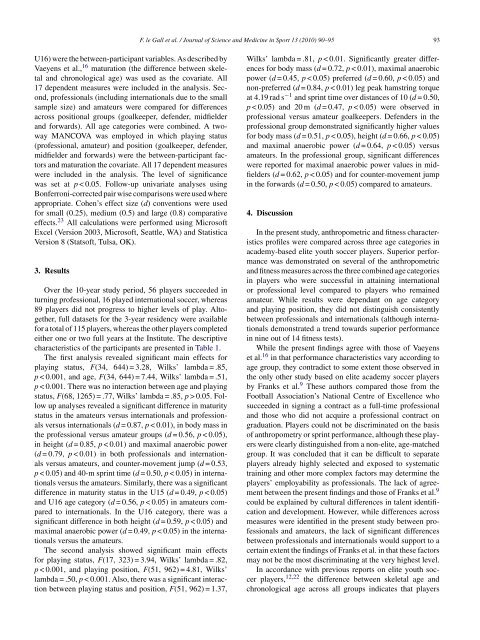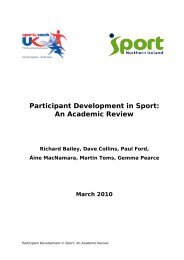ANTHROPOMETRIC
ANTHROPOMETRIC AND FITNESS IN SOCCER
ANTHROPOMETRIC AND FITNESS IN SOCCER
Create successful ePaper yourself
Turn your PDF publications into a flip-book with our unique Google optimized e-Paper software.
U16) were the between-participant variables. As described by<br />
Vaeyens et al., 16 maturation (the difference between skeletal<br />
and chronological age) was used as the covariate. All<br />
17 dependent measures were included in the analysis. Second,<br />
professionals (including internationals due to the small<br />
sample size) and amateurs were compared for differences<br />
across positional groups (goalkeeper, defender, midfielder<br />
and forwards). All age categories were combined. A twoway<br />
MANCOVA was employed in which playing status<br />
(professional, amateur) and position (goalkeeper, defender,<br />
midfielder and forwards) were the between-participant factors<br />
and maturation the covariate. All 17 dependent measures<br />
were included in the analysis. The level of significance<br />
was set at p < 0.05. Follow-up univariate analyses using<br />
Bonferroni-corrected pair wise comparisons were used where<br />
appropriate. Cohen’s effect size (d) conventions were used<br />
for small (0.25), medium (0.5) and large (0.8) comparative<br />
effects. 23 All calculations were performed using Microsoft<br />
Excel (Version 2003, Microsoft, Seattle, WA) and Statistica<br />
Version 8 (Statsoft, Tulsa, OK).<br />
3. Results<br />
Over the 10-year study period, 56 players succeeded in<br />
turning professional, 16 played international soccer, whereas<br />
89 players did not progress to higher levels of play. Altogether,<br />
full datasets for the 3-year residency were available<br />
for a total of 115 players, whereas the other players completed<br />
either one or two full years at the Institute. The descriptive<br />
characteristics of the participants are presented in Table 1.<br />
The first analysis revealed significant main effects for<br />
playing status, F(34, 644) = 3.28, Wilks’ lambda = .85,<br />
p < 0.001, and age, F(34, 644) = 7.44, Wilks’ lambda = .51,<br />
p < 0.001. There was no interaction between age and playing<br />
status, F(68, 1265) = .77, Wilks’ lambda = .85, p > 0.05. Follow<br />
up analyses revealed a significant difference in maturity<br />
status in the amateurs versus internationals and professionals<br />
versus internationals (d = 0.87, p < 0.01), in body mass in<br />
the professional versus amateur groups (d = 0.56, p < 0.05),<br />
in height (d = 0.85, p < 0.01) and maximal anaerobic power<br />
(d = 0.79, p < 0.01) in both professionals and internationals<br />
versus amateurs, and counter-movement jump (d = 0.53,<br />
p < 0.05) and 40-m sprint time (d = 0.50, p < 0.05) in internationals<br />
versus the amateurs. Similarly, there was a significant<br />
difference in maturity status in the U15 (d = 0.49, p < 0.05)<br />
and U16 age category (d = 0.56, p < 0.05) in amateurs compared<br />
to internationals. In the U16 category, there was a<br />
significant difference in both height (d = 0.59, p < 0.05) and<br />
maximal anaerobic power (d = 0.49, p < 0.05) in the internationals<br />
versus the amateurs.<br />
The second analysis showed significant main effects<br />
for playing status, F(17, 323) = 3.94, Wilks’ lambda = .82,<br />
p < 0.001, and playing position, F(51, 962) = 4.81, Wilks’<br />
lambda = .50, p < 0.001. Also, there was a significant interaction<br />
between playing status and position, F(51, 962) = 1.37,<br />
F. le Gall et al. / Journal of Science and Medicine in Sport 13 (2010) 90–95 93<br />
Wilks’ lambda = .81, p < 0.01. Significantly greater differences<br />
for body mass (d = 0.72, p < 0.01), maximal anaerobic<br />
power (d = 0.45, p < 0.05) preferred (d = 0.60, p < 0.05) and<br />
non-preferred (d = 0.84, p < 0.01) leg peak hamstring torque<br />
at 4.19 rad s −1 and sprint time over distances of 10 (d = 0.50,<br />
p < 0.05) and 20 m (d = 0.47, p < 0.05) were observed in<br />
professional versus amateur goalkeepers. Defenders in the<br />
professional group demonstrated significantly higher values<br />
for body mass (d = 0.51, p < 0.05), height (d = 0.66, p < 0.05)<br />
and maximal anaerobic power (d = 0.64, p < 0.05) versus<br />
amateurs. In the professional group, significant differences<br />
were reported for maximal anaerobic power values in midfielders<br />
(d = 0.62, p < 0.05) and for counter-movement jump<br />
in the forwards (d = 0.50, p < 0.05) compared to amateurs.<br />
4. Discussion<br />
In the present study, anthropometric and fitness characteristics<br />
profiles were compared across three age categories in<br />
academy-based elite youth soccer players. Superior performance<br />
was demonstrated on several of the anthropometric<br />
and fitness measures across the three combined age categories<br />
in players who were successful in attaining international<br />
or professional level compared to players who remained<br />
amateur. While results were dependant on age category<br />
and playing position, they did not distinguish consistently<br />
between professionals and internationals (although internationals<br />
demonstrated a trend towards superior performance<br />
in nine out of 14 fitness tests).<br />
While the present findings agree with those of Vaeyens<br />
et al. 16 in that performance characteristics vary according to<br />
age group, they contradict to some extent those observed in<br />
the only other study based on elite academy soccer players<br />
by Franks et al. 9 These authors compared those from the<br />
Football Association’s National Centre of Excellence who<br />
succeeded in signing a contract as a full-time professional<br />
and those who did not acquire a professional contract on<br />
graduation. Players could not be discriminated on the basis<br />
of anthropometry or sprint performance, although these players<br />
were clearly distinguished from a non-elite, age-matched<br />
group. It was concluded that it can be difficult to separate<br />
players already highly selected and exposed to systematic<br />
training and other more complex factors may determine the<br />
players’ employability as professionals. The lack of agreement<br />
between the present findings and those of Franks et al. 9<br />
could be explained by cultural differences in talent identification<br />
and development. However, while differences across<br />
measures were identified in the present study between professionals<br />
and amateurs, the lack of significant differences<br />
between professionals and internationals would support to a<br />
certain extent the findings of Franks et al. in that these factors<br />
may not be the most discriminating at the very highest level.<br />
In accordance with previous reports on elite youth soccer<br />
players, 12,22 the difference between skeletal age and<br />
chronological age across all groups indicates that players




